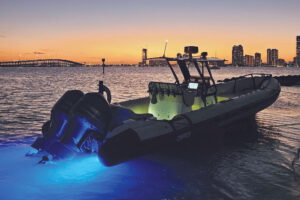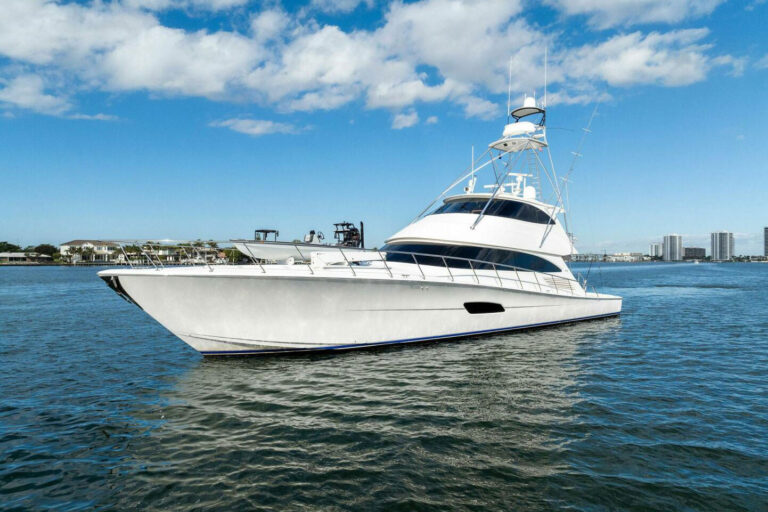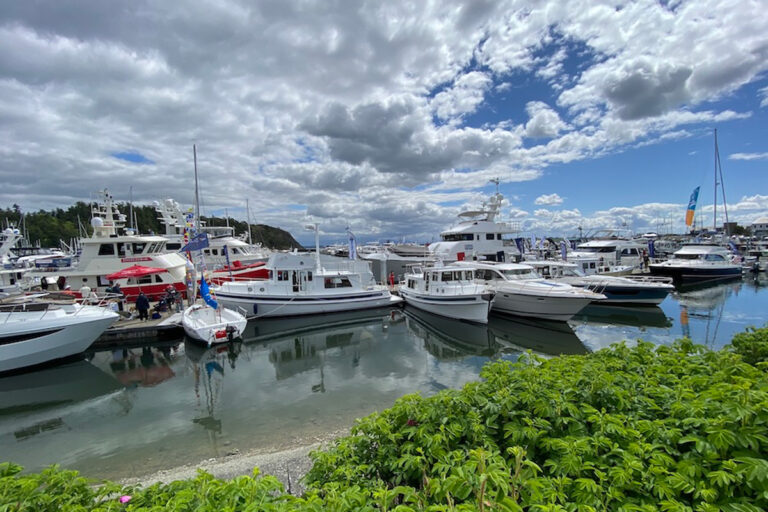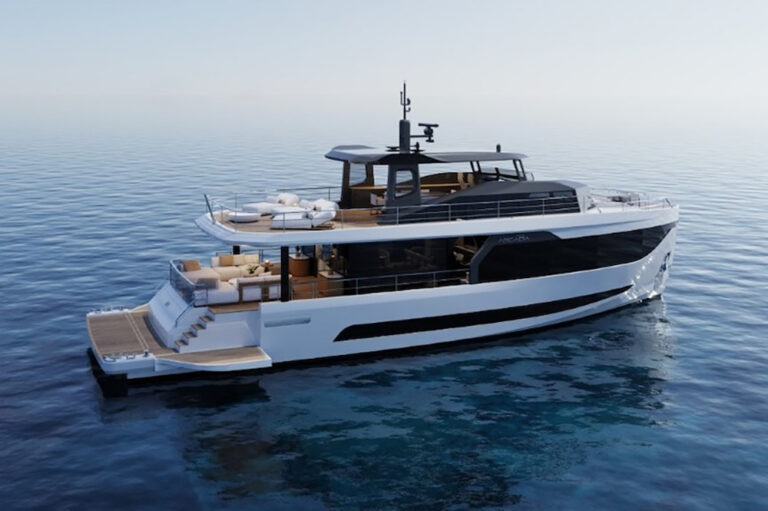When futuristic technologies merge, big things can happen for smaller yachts.
The latest example is the new TracVision G8 antenna from KVH Industries, which uses fiber-optic gyro stabilization, an internal GPS engine and chip-based mass data storage to allow the same satellite broadband/TV reception on midrange yachts that larger antennas offer on the world’s superyachts.
Take fringe areas such as the Caribbean, where reception can be so bad that stabilized antennas using traditional technology must be at least 42 inches in diameter and housed in a 50-inch dome. That’s fine-for yachts 120 feet and larger. KVH’s new G8 antenna is the first to pack the technology into a 32-inch carbon-fiber dish in a 34-inch dome. It should fit comfortably on yachts down to about 80 feet LOA, yet still deliver the same fringe-area reception.
A simplified user interface (the master control unit) contains the system’s memory and supervises all the new technology, but KVH’s home-grown fiber optic gyro devices remain at the system’s heart. These FOGs, as they’re known, use light instead of spinning metal to provide more precise stabilization than older gyro schemes.
The antenna is among the first in what may be a string of new applications for a fiber optic gyro.
HOGSHEAD BE GONE
Ever notice that electronic navigation devices tend to be least reliable just when you need them the most, when you’re offshore, visibility is short and the seas are rough? There’s a reason for this beyond Murphy’s Law.
When your vessel rolls and pitches and heaves, the radar becomes difficult to interpret. Large areas of sea clutter fill the screen. The GPS becomes intermittent as the antenna drops satellites. The compass becomes less readable as its card swings through large arcs. Even the folks trying to watch satellite TV belowdecks discover the antenna cannot find and hold a station.
The fact is, all this hardware works much better in flat seas, when “up is directly overhead and perpendicular to the boat’s horizontal and longitudinal axis.
Absent flat seas, today’s more sophisticated radar, navigation systems, compasses and satellite antenna systems will accept stabilization inputs from a ship’s gyro, traditionally a relatively massive spinning metal device housed belowdecks in a metal enclosure that resembles a hogshead. The largest yachts can provide the space and weight these spinning metal gyros demand, but until just a few years ago, smaller yachts had to do without.
Enter the fiber optic gyro. They’re tiny. They’re light. They allow more precise stabilization inputs to come from a much smaller device. Even when three FOGs and a couple of accelerometers are put together to create an inertial platform, the resulting package is about the size of a cigar box.
A first use in the recreational marine industry was KVH’s GyroTrac, a fiber optic gyro stabilized magnetic compass system (“Head’s Up About Your Heading, June 2001). It’s internal mechanism is the same as the one KVH is applying to the new antenna.
LASER POWER
When removed from its housing, a FOG looks like a reel full of monofilament fishing line mounted on a printed circuit board. FOGs work by spinning light rather than iron. To understand how they operate, a basic tutorial on mechanical gyros is necessary.
Think of a spinning top. It remains upright and perpendicular to the Earth’s surface. As it slows, it wobbles and eventually topples over. If you put the top on a book and, while the top is spinning, pick up and tip the book, the top will remain perpendicular to the Earth, but its angle to the book will change.
A mechanical marine gyro operates on the same general principle. It is a spinning object, often a highly polished bearing or disc, put into motion in a vacuum or liquid and fed power to maintain a constant rotation (so it won’t wobble and topple over). The gyro will remain perpendicular to the surface of the Earth even as the Earth rotates. If the boat using the gyro is motionless and flat, the gyro will have the same angle to the boat and to the Earth. Once the boat begins to move, the angle between the gyro and the boat will change. Mechanical gyros measure the difference in this angle. Combined gyros can measure movement in three dimensions.
A FOG, on the other hand, basically works like this: A beam is fired from a laser. As it passes along the fiber, it is “split into two smaller, dimmer portions. The optical fiber then branches into a circular coil. One half of the light goes clockwise around the loop while the other half goes counterclockwise. The coil is the same length regardless of direction. If the FOG is motionless, the two pieces of light will return to the starting point at exactly the same time. When they do, they are recombined into the single, original bright light, which can be measured.
This won’t happen if the FOG is rotating. Think of the coil of fiber as sitting in a box on a tabletop. The beams head in opposite directions. Each one has to travel the same distance to get around the coil and back to the starting point. As the light travels, you reach down and turn the box clockwise 45 degrees. By doing so, you’ve shortened the distance back to the starting line for the beam traveling counterclockwise and moved the starting line away from the beam traveling clockwise. As a result, the beams will not reach the finish line at the same time and will not be recombined into a single, bright light. Instead, they will be slightly out of phase.
A FOG measures this “phase difference.
THE FUTURE OF FOG
FOGs literally have no moving parts: no spinning bearings, no liquid-and no periodic maintenance. Also worth noting is that a FOG’s mean time between failures is about 50,000 hours, compared with 5,000 to 10,000 hours for metal gyros.
KVH’s GyroTrac, a FOG-stabilized digital marine compass with outputs for additional ship’s systems, retails for just under $3,000, or about one-quarter the cost of a traditional gyro compass system. The new G8 antenna sells for about $15,000. Since FOGs cost about $1,000 per axis to make, and KVH appears to be alone in bringing new applications to the marketplace, don’t expect to see large price drops soon.
What we can expect is greater integration of FOGs into high-end systems that need stabilization. As the technology trickles down, smaller-yacht components will perform better.








